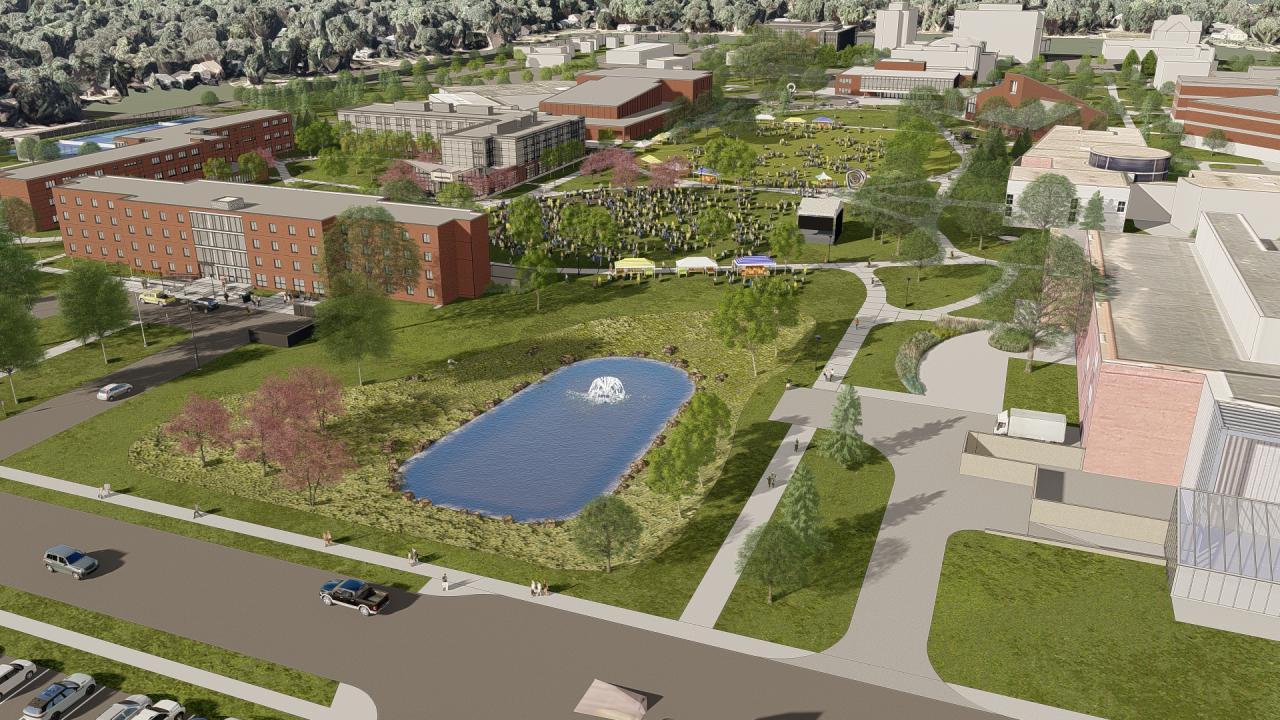Private four-year academic institutions provide more space per in-person student than other sectors. Town and rural schools provide more space per in-person student than urban and suburban schools. Institutions with fewer than 5,000 in-person students offer the most instructional space per in-person student. And small public four-year institutions provide much more research lab space than small private four-year schools.
These are some of the findings in the Society for College and University Planning’s 2022 Campus Facilities Inventory Report. CFI is a national database that helps universities compare their campus development to peer institutions. The quantitative section of the 2022 Report is based on responses from 104 institutions across the U.S. and one in Canada, and its results were released a few weeks ago.
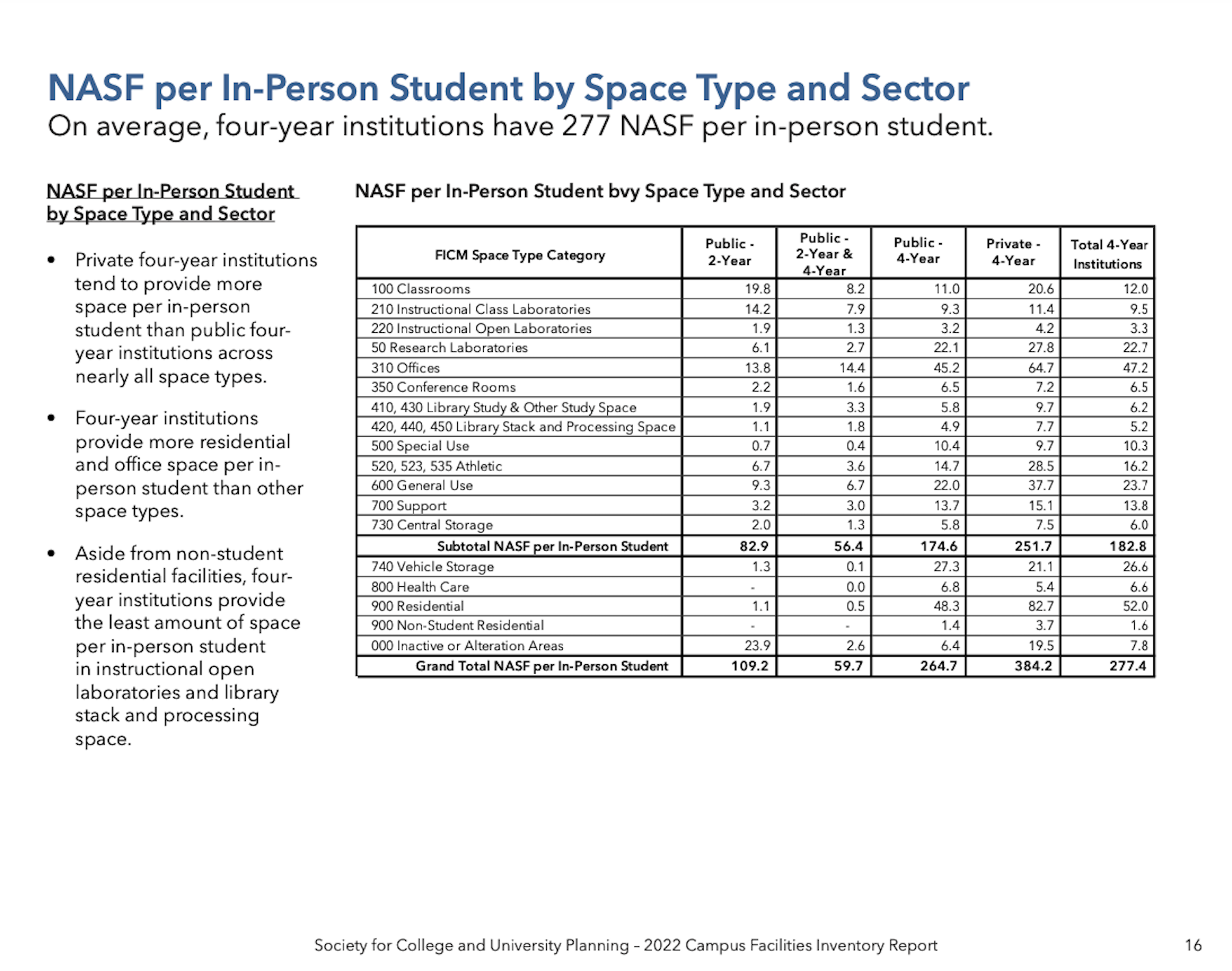
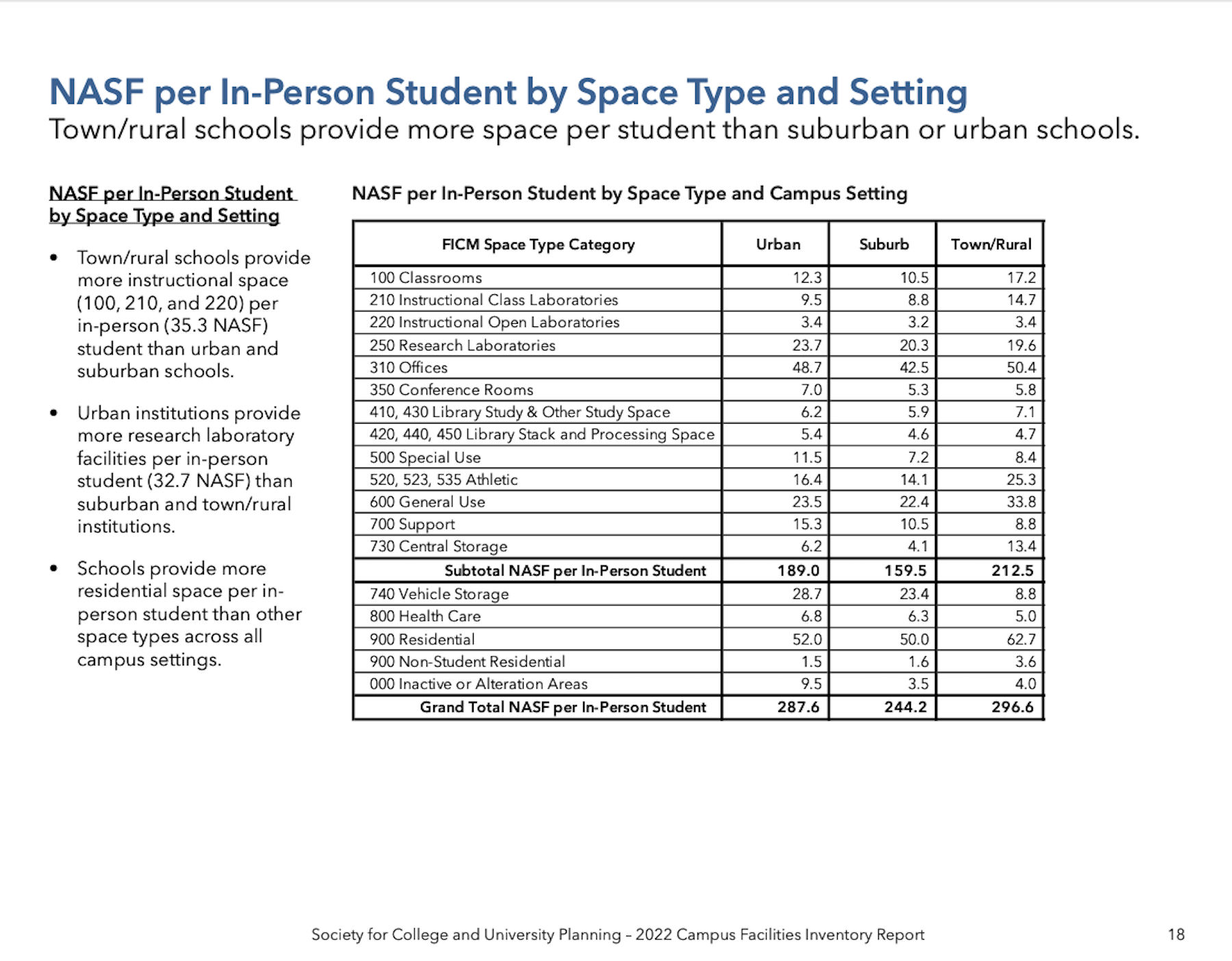
SCUP, a nonprofit professional association that since 1966 has supported college planners, in 2021 partnered with brightspot strategy, a Buro Happold company, to relaunch the Campus Facilities Inventory, (CFI) which originally had been collected and published in 2003-2007. The latest CFI increases the room-use categories tracked to 19, from 15 in the original version. The categories are derived from the National Center for Education Statistics Postsecondary Education Facilities Inventory and Classification Manual.
A sample of the CFI findings shows that small private four-year institutions average 58.7 net aggregate square feet of instructional space per in-person student compared to 35.2 sf that their public counterparts offer.
DEVELOPMENT PLANS GAUGED
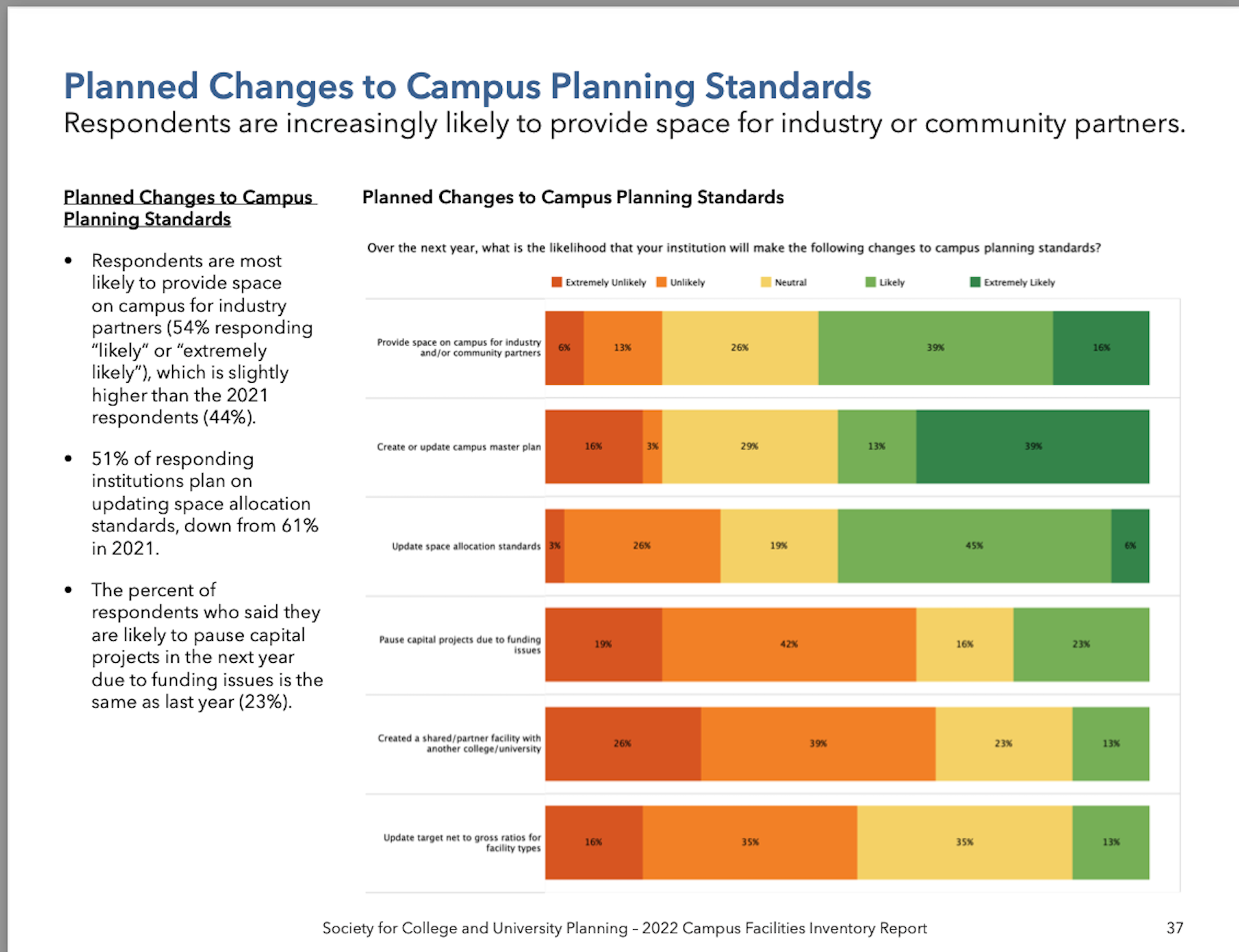
The 2022 Report includes questions about qualitative changes to space on campus—both changes that have been made recently or are likely to be made in the next three years. Thirty-one institutions participated in this part of the survey, the majority of which are four-year public schools. The survey found that respondents are more likely to update or adapt existing facilities, rather than build new ones; are more likely to make changes to administrative office facilities than academic offices; and expect 80 percent of faculty and staff to be working either fully on campus or on campus 3-4 days per week.
Based on responses, investments in campus computing infrastructure and technology systems within facilities are highly likely over the next year. More than half of the respondents said they plan to increase their computational research laboratory and fabrication/maker space facilities. And these respondents also intent to make greater use of outdoor spaces next year.
Interestingly, compared to 2021, more respondents reported decommissioning facilities over the past year. The most common space types for decommissioning were workspaces and research labs. That trend is expected to continue over the following three years.
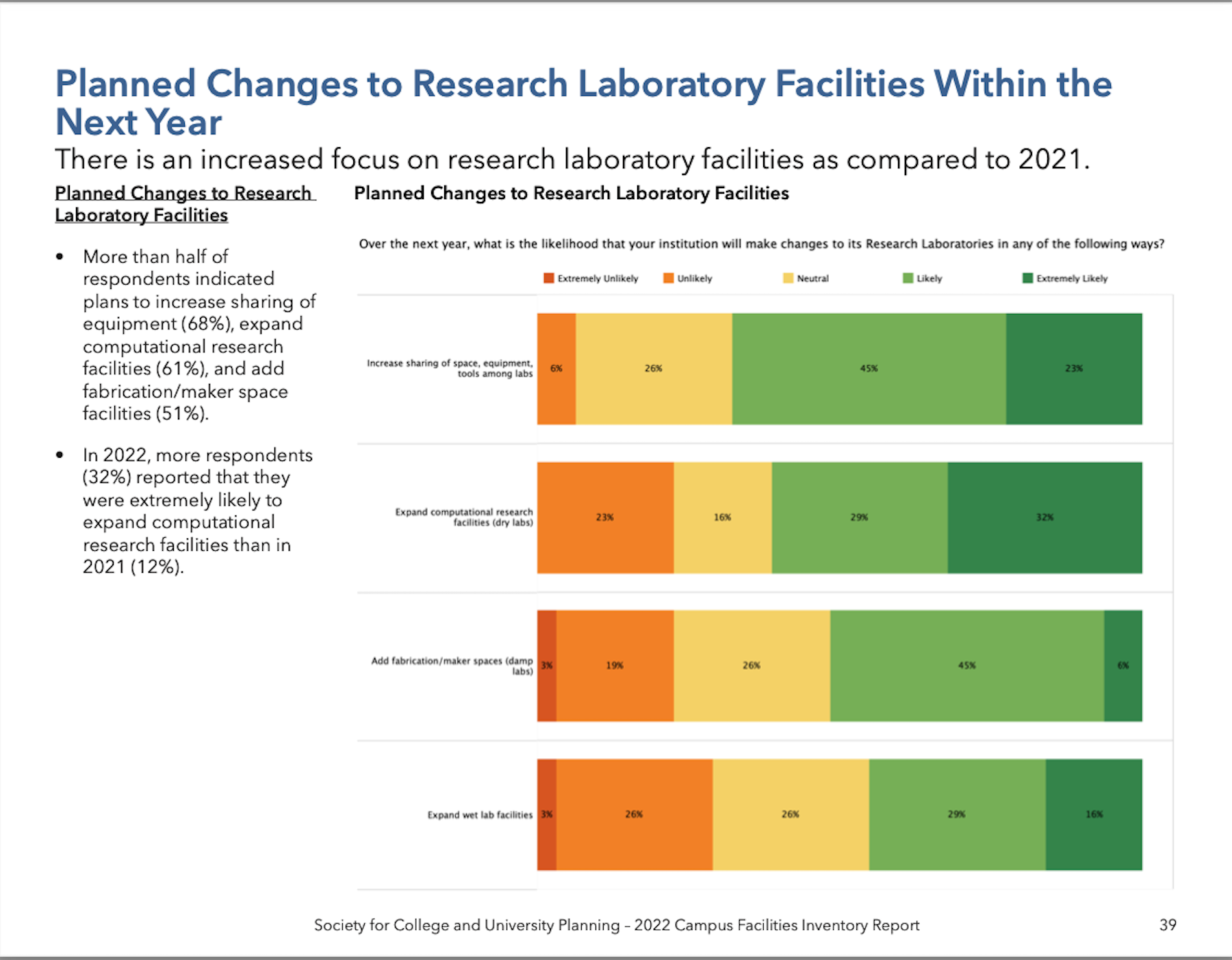
Athletic and recreation facilities moved up to the No. 2 facility type (from No. 7 in 2021) for planned facility updates, right behind classrooms. Adaptive reuse of existing facilities continues to top the list of planned changes to campus facilities, increasing to 84 percent of respondents, from 76 percent in 2021. And when it comes to library and study facilities, respondents are much less likely to move collections off-campus compared to 2021.
ADDING RESEARCH LABS A PRIORITY
Respondents are increasingly likely to provide space for industry or community partners. The 2022 respondents reported a greater focus on research labs, and on updating meeting room technology for virtual engagements.
College planners are also placing greater emphasis on expanding their institutions’ capacities for student health services. While centralizing health and wellness facilities on campus seems to be a nonstarter for many schools, more than two-fifths of respondents plan to design wellness into their student living facilities.
Sadie Wutka, SCUP’s Director of Content Strategy, tells BD+C that while the Society currently collects data yearly, that could change “as we determine the best cadence to provide accurate, timely data without overly burdening the institutions that submit it.
In response to BD+C’s emailed questions, Wutka and Allan Donnelly, brightspot strategy’s Associate Director, wrote that SCUP’s short-term priority is to increase the number of survey respondents “so we can develop a more robust data source.” SCUP is exploring new ways to aggregate data to make the information more useful to institutions, such as reporting out space use per region in the U.S.
Aside from the CFI Report, SCUP creates a range of learning opportunities, said Wukta, that includes publications and the Society’s annual conference.
VOLATILE ENVIRONMENT
Wutka said that the coronavirus pandemic accelerated changes that were already impacting higher education “and launched us into an even more intensely volatile, uncertain, complex, and ambiguous environment.” She pointed specifically to the “demographic cliff”—the decreasing numbers of adolescent students—that Northeastern and Midwestern institutions are now staring into. Other institutions are facing challenges related to state legislation and funding appropriations cuts.
“Higher education institutions need to anticipate the trends and movements that will impact them, and develop an integrated planning culture that builds relationships, aligns the institution, and prepares them to change and adapt,” said Wutka and Donnelly.
SCUP is currently into its 2018-2023 strategic plan that Wutka said has been “instrumental” in helping the Society and its members weather the pandemic. “We pivoted to remote conferences, reintroduced webinar programming, and developed an emerging leader program,” as well as SCUP Coaching, which helps institutions tackle planning challenges. Wukta said SCUP will initiate the process for its next five-year plan this coming fall.
Related Stories
| Aug 11, 2010
Florida International University's cantilevered design
Suffolk Construction's Miami-Dade business unit is serving as GC for the $14 million School of International and Public Affairs building at the University Park Campus of Florida International University. Designed by Arquitectonica, Miami, the five-story, 58,408-sf building will have a café and three auditoriums on the ground level; the largest auditorium will have a 40-foot cantilever abov...
| Aug 11, 2010
Concrete Solutions
About five or six years ago, officials at the University of California at Berkeley came to the conclusion that they needed to build a proper home for the university's collection of 900,000 rare Chinese, Japanese, and Korean books and materials. East Asian studies is an important curriculum at Berkeley, with more than 70 scholars teaching some 200 courses devoted to the topic, and Berkeley's pro...
| Aug 11, 2010
Research Facility Breaks the Mold
In the market for state-of-the-art biomedical research space in Boston's Longwood Medical Area? Good news: there are still two floors available in the Center for Life Science | Boston, a multi-tenant, speculative high-rise research building designed by Tsoi/Kobus & Associates, Boston, and developed by Lyme Properties, Hanover, N.
| Aug 11, 2010
Precast All the Way
For years, precast concrete has been viewed as a mass-produced product with no personality or visual appeal—the vanilla of building materials. Thanks to recent technological innovations in precast molds and thin veneers, however, that image is changing. As precast—concrete building components that are poured and molded offsite—continues to develop a vibrant personality all it...
| Aug 11, 2010
Living and Learning Center, Massachusetts College of Pharmacy & Health Sciences
From its humble beginnings as a tiny pharmaceutical college founded by 14 Boston pharmacists, the Massachusetts College of Pharmacy & Health Sciences has grown to become the largest school of its kind in the U.S. For more than 175 years, MCPHS operated solely in Boston, on a quaint, 2,500-student campus in the heart of the city's famed Longwood Medical and Academic Area.
| Aug 11, 2010
Giants 300 University Report
University construction spending is 13% higher than a year ago—mostly for residence halls and infrastructure on public campuses—and is expected to slip less than 5% over the next two years. However, the value of starts dropped about 10% in recent months and will not return to the 2007–08 peak for about two years.
| Aug 11, 2010
Bowing to Tradition
As the home to Harvard's Hasty Pudding Theatricals—the oldest theatrical company in the nation—12 Holyoke Street had its share of opening nights. In April 2002, however, the Faculty of Arts and Sciences decided the 1888 Georgian Revival building no longer met the needs of the company and hired Boston-based architect Leers Weinzapfel Associates to design a more contemporary facility.
| Aug 11, 2010
Team Tames Impossible Site
Rensselaer Polytechnic Institute, the nation's oldest technology university, has long prided itself on its state-of-the-art design and engineering curriculum. Several years ago, to call attention to its equally estimable media and performing arts programs, RPI commissioned British architect Sir Nicholas Grimshaw to design the Curtis R.
| Aug 11, 2010
Setting the Green Standard For Community Colleges
“Ohlone College Newark Campus Is the Greenest College in the World!” That bold statement was the official tagline of the festivities surrounding the August 2008 grand opening of Ohlone College's LEED Platinum Newark (Calif.) Center for Health Sciences and Technology. The 130,000-sf, $58 million community college facility stacks up against some of the greenest college buildings in th...
| Aug 11, 2010
University of Arizona College of Medicine
The hope was that a complete restoration and modernization would bring life back to three neoclassic beauties that formerly served as Phoenix Union High School—but time had not treated them kindly. Built in 1911, one year before Arizona became the country's 48th state, the historic high school buildings endured nearly a century of wear and tear and suffered major water damage and years of...


